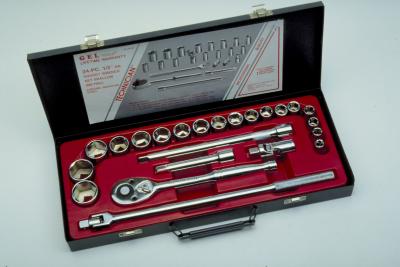
Head studs are bolt-like parts that are threaded on both ends. One end threads into the engine block. The head (or heads if it is a V-shaped engine) of the engine is then installed onto the block by sliding it down over the studs. Nuts are then threaded onto the head studs to hold the head in place. Head studs ensure that there is no movement or stretching of the head when the engine encounters extreme heat. ARP head studs are a great performance upgrade for modified engines since they are stronger and much more durable than the majority of stock head studs.
Clean the surface of the block so that there are no traces of old head gasket material. Ideally, you should install ARP head studs after the top of the deck has been machined. Ensure that you do not scratch or mar the surface of the block when you clean it. Use gasket remover and scrapers to clean it, or use steel wool.
Lay the ARP head studs out on a clean rag. Examine the head studs, which are threaded on both ends. One end threads into the block and will likely have less threads than the opposite end, which is where the nuts that secure the head to the block are fastened. The end with the hex head-shaped recess in it should be facing up.
Apply a thin layer of moly lube to the end of the stud that threads into the block, which is the end opposite the hex head recess. Ensure that the threaded holes in the block are free of debris. Thread one head stud into each hole on the surface of the block where the heads mount. Tighten the studs by hand.
Add a thin layer of the moly lube to the top threads of the head studs. Slide a new head gasket down over the head studs, aligning the holes in the head studs so that the head gasket slides down over the studs and seats on the top of the block.
Verify that the mating surface of the head (or heads, if it a V-shaped motor) is entirely clean and free of old gasket material. Again, the heads should be machined for the new head gasket, but this is not a requirement.
Slide the cylinder head down the head studs so that it seats squarely on the block. Make sure the head does not go on crooked as this may cause it to bind on the head studs. Also, watch out for your fingers. Sometimes the head slides down the studs quickly.
Install the supplied ARP washers onto each of the head studs. It may help to use a pair of needle-nose pliers to install these. Hold the washer with the pliers then slide them over the head studs so they rest on top of the heads.
Thread the ARP nuts onto each of the studs. Consult a workshop manual for the proper order in which to tighten the nuts to avoid warping the head. Tighten the head stud nuts to 30 ft.-lbs. with a torque wrench according to the sequence for your engine. Tighten the nuts to 60 ft.-lbs. and then to 90 ft.-lbs. in the same sequence. Again, it is important to consult your workshop manual as well as the directions that came with the ARP head studs to ensure that the nuts are tightened to the proper specifications.
Check the tightness of the head studs at 500 miles. Tighten them with a torque wrench if necessary.